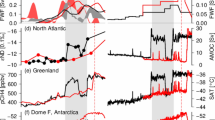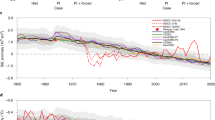Abstract
According to the Milankovitch theory, changes in summer insolation in the high-latitude Northern Hemisphere caused glacial cycles through their impact on ice-sheet mass balance1. Statistical analyses of long climate records supported this theory, but they also posed a substantial challenge by showing that changes in Southern Hemisphere climate were in phase with or led those in the north2. Although an orbitally forced Northern Hemisphere signal may have been transmitted to the Southern Hemisphere3, insolation forcing can also directly influence local Southern Hemisphere climate, potentially intensified by sea-ice feedback4,5,6, suggesting that the hemispheres may have responded independently to different aspects of orbital forcing. Signal processing of climate records cannot distinguish between these conditions, however, because the proposed insolation forcings share essentially identical variability7. Here we use transient simulations with a coupled atmosphere–ocean general circulation model to identify the impacts of forcing from changes in orbits, atmospheric CO2 concentration, ice sheets and the Atlantic meridional overturning circulation (AMOC) on hemispheric temperatures during the first half of the last deglaciation (22–14.3 kyr bp). Although based on a single model, our transient simulation with only orbital changes supports the Milankovitch theory in showing that the last deglaciation was initiated by rising insolation during spring and summer in the mid-latitude to high-latitude Northern Hemisphere and by terrestrial snow–albedo feedback. The simulation with all forcings best reproduces the timing and magnitude of surface temperature evolution in the Southern Hemisphere in deglacial proxy records8,9. AMOC changes associated with an orbitally induced retreat of Northern Hemisphere ice sheets10 is the most plausible explanation for the early Southern Hemisphere deglacial warming and its lead over Northern Hemisphere temperature; the ensuing rise in atmospheric CO2 concentration provided the critical feedback on global deglaciation9,11.
This is a preview of subscription content, access via your institution
Access options
Subscribe to this journal
Receive 51 print issues and online access
$199.00 per year
only $3.90 per issue
Buy this article
- Purchase on Springer Link
- Instant access to full article PDF
Prices may be subject to local taxes which are calculated during checkout




Similar content being viewed by others
References
Milanković, M. Canon of Insolation and the Ice-age Problem [Kanon der Erdbestrahlung und seine Anwendung auf das Eiszeitenproblem] Belgrade. 1941. (Israel Program for Scientific Translations, 1969)
Hays, J. D., Imbrie, J. & Shackleton, N. J. Variations in Earth’s orbit—pacemaker of ice ages. Science 194, 1121–1132 (1976)
Imbrie, J. et al. On the structure and origin of major glaciation cycles. 1. Linear responses to Milankovitch forcing. Paleoceanography 7, 701–738 (1992)
Stott, L., Timmermann, A. & Thunell, R. Southern hemisphere and deep-sea warming led deglacial atmospheric CO2 rise and tropical warming. Science 318, 435–438 (2007)
Huybers, P. & Denton, G. Antarctic temperature at orbital timescales controlled by local summer duration. Nature Geosci. 1, 787–792 (2008)
Timmermann, A., Timm, O., Stott, L. & Menviel, L. The roles of CO2 and orbital forcing in driving Southern Hemispheric temperature variations during the last 21 000 yr. J. Clim. 22, 1626–1640 (2009)
Huybers, P. Antarctica’s orbital beat. Science 325, 1085–1086 (2009)
Shakun, J. D. & Carlson, A. E. A global perspective on Last Glacial Maximum to Holocene climate change. Quat. Sci. Rev. 29, 1801–1816 (2010)
Shakun, J. D. et al. Global warming preceded by increasing carbon dioxide concentrations during the last deglaciation. Nature 484, 49–54 (2012)
Clark, P. U. et al. The Last Glacial Maximum. Science 325, 710–714 (2009)
Ruddiman, W. F. Ice-driven CO2 feedback on ice volume. Clim. Past Discuss. 2, 43–55 (2006)
Liu, Z. et al. Transient simulation of last deglaciation with a new mechanism for Bolling–Allerod warming. Science 325, 310–314 (2009)
Berger, A. L. Long-term variations of daily insolation and Quaternary climatic changes. J. Atmos. Sci. 35, 2362–2367 (1978)
Joos, F. & Spahni, R. Rates of change in natural and anthropogenic radiative forcing over the past 20,000 years. Proc. Natl Acad. Sci. USA 105, 1425–1430 (2008)
Peltier, W. R. Global glacial isostasy and the surface of the ice-age earth: the ICE-5G (VM2) model and GRACE. Annu. Rev. Earth Planet. Sci. 32, 111–149 (2004)
Timm, O., Timmermann, A., Abe-Ouchi, A., Saito, F. & Segawa, T. On the definition of seasons in paleoclimate simulations with orbital forcing. Paleoceanography 23, PA2221 (2008)
Chen, G. S., Kutzbach, J. E., Gallimore, R. & Liu, Z. Y. Calendar effect on phase study in paleoclimate transient simulation with orbital forcing. Clim. Dyn. 37, 1949–1960 (2011)
Huybers, P. & Wunsch, C. Obliquity pacing of the late Pleistocene glacial terminations. Nature 434, 491–494 (2005)
Fischer, H. et al. The role of Southern Ocean processes in orbital and millennial CO2 variations—a synthesis. Quat. Sci. Rev. 29, 193–205 (2010)
Pedro, J. B., Rasmussen, S. O. & van Ommen, T. D. Tightened constraints on the time-lag between Antarctic temperature and CO2 during the last deglaciation. Clim. Past 8, 1213–1221 (2012)
Cheng, H. et al. Ice age terminations. Science 326, 248–252 (2009)
Denton, G. H. et al. The last glacial termination. Science 328, 1652–1656 (2010)
Crowley, T. J. North Atlantic deep water cools the Southern Hemisphere. Paleoceanography 7, 489–497 (1992)
Caillon, N. et al. Timing of atmospheric CO2 and Antarctic temperature changes across termination. III. Science 299, 1728–1731 (2003)
Hansen, J. et al. Climate change and trace gases. Phil. Trans. R. Soc. A 365, 1925–1954 (2007)
McManus, J. F., Oppo, D. W. & Cullen, J. L. A 0.5-million-year record of millennial-scale climate variability in the North Atlantic. Science 283, 971–975 (1999)
Martrat, B. et al. Four climate cycles of recurring deep and surface water destabilizations on the Iberian margin. Science 317, 502–507 (2007)
Carlson, A. E. & Clark, P. U. Ice-sheet sources of sea level rise and freshwater discharge during the last deglaciation. Rev. Geophys.. 50 RG4007 http://dx.doi.org/10.1029/2011RG000371 (2012)
McManus, J. F., Francois, R., Gherardi, J. M., Keigwin, L. D. & Brown-Leger, S. Collapse and rapid resumption of Atlantic meridional circulation linked to deglacial climate changes. Nature 428, 834–837 (2004)
Cuffey, K. M. & Clow, G. D. Temperature, accumulation, and ice sheet elevation in central Greenland through the last deglacial transition. J. Geophys. Res. 102 (C12). 26383–26396 (1997)
Acknowledgements
We thank O. Timm and A. Timmermann for fruitful discussions, and G. Chen for providing the conversion code for fix-angular calendar. We thank the University Corporation for Atmospheric Research for continuous development of the community Earth system model. This research used resources of the Oak Ridge Leadership Computing Facility, located in the National Center for Computational Sciences at Oak Ridge National Laboratory, which is supported by the Office of Science of the Department of Energy under contract DE-AC05-00OR22725. F.H. is supported by the US National Science Foundation (AGS-0902802, AGS-1203430) and the Climate, People, and the Environment Program. P.U.C. and J.D.S. were supported by the Paleoclimate Program of the National Science Foundation through project PALEOVAR (06023950-ATM). This is CCR contribution no. 1130.
Author information
Authors and Affiliations
Contributions
F.H. and Z.L. conceived this study. F.H. initiated and performed all the single-forcing transient simulations and wrote the manuscript with P.U.C. J.D.S. provided and synthesized the proxy data. A.E.C. and P.U.C. constructed the meltwater forcing schemes with F.H., Z.L. and B.O.-B. Z.L. and B.O.-B. initiated the transient simulation project and provided the computational resources. J.E.K. helped interpret the calendar effect of insolation. All authors discussed the results and provided input on the manuscript.
Corresponding author
Ethics declarations
Competing interests
The authors declare no competing financial interests.
Supplementary information
Supplementary Information
This file contains Supplementary Figures 1-28, Supplementary Discussions 1-2 and Supplementary References. (PDF 3489 kb)
Rights and permissions
About this article
Cite this article
He, F., Shakun, J., Clark, P. et al. Northern Hemisphere forcing of Southern Hemisphere climate during the last deglaciation. Nature 494, 81–85 (2013). https://doi.org/10.1038/nature11822
Received:
Accepted:
Published:
Issue Date:
DOI: https://doi.org/10.1038/nature11822
This article is cited by
-
Deglacial perspectives of future sea level for Singapore
Communications Earth & Environment (2023)
-
Decadal warming events extended into central North America during the last glacial period
Nature Geoscience (2023)
-
Freshwater forcing of the Atlantic Meridional Overturning Circulation revisited
Nature Climate Change (2022)
-
Three modes of climate change since the Last Glacial Maximum in arid and semi-arid regions of the Asian continent
Journal of Geographical Sciences (2022)
-
700,000 years of tropical Andean glaciation
Nature (2022)
Comments
By submitting a comment you agree to abide by our Terms and Community Guidelines. If you find something abusive or that does not comply with our terms or guidelines please flag it as inappropriate.



